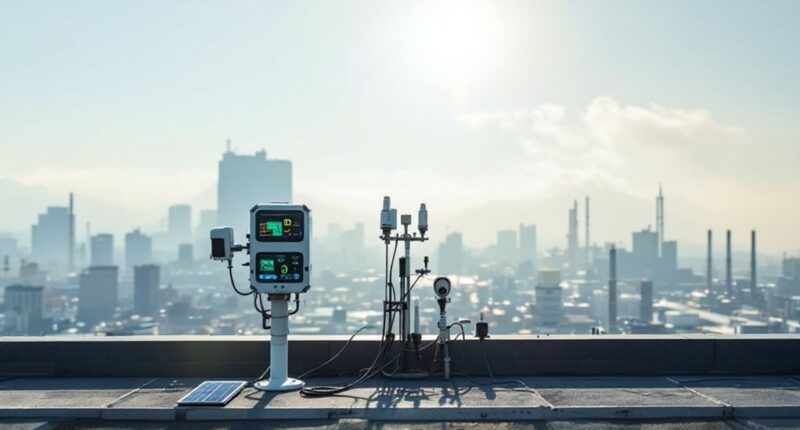Air quality monitoring combines high-tech precision with public accessibility. From stationary stations and mobile drones to gas analyzers and optical particle counters, experts track particulate matter, nitrogen oxides, and other pollutants that affect our health. Compliance standards vary globally, with the WHO and EPA establishing benchmarks that communities must meet. The future balances sophisticated reference-grade monitors with democratized low-cost sensors, expanding both coverage and participation. The air we breathe has never been more closely watched.

The invisible elements that surround us daily have stepped into the spotlight as air quality monitoring takes center stage in environmental science. Once the domain of specialized researchers, tracking what we breathe has become a high-tech pursuit employing an arsenal of sophisticated tools—from stationary monitoring stations that diligently sample air 24/7 to nimble drones that zip through urban canyons capturing pollution snapshots.
These monitoring systems target the usual suspects of air pollution: particulate matter (those microscopic troublemakers small enough to infiltrate your lungs), nitrogen oxides (NOx, the temperamental byproducts of combustion), sulfur dioxide (SO2, industry’s pungent calling card), and ground-level ozone (O3, the Jekyll and Hyde molecule that’s protective in the stratosphere but problematic at street level). Passive sampling methods utilize diffusion tubes for cost-effective monitoring of pollutants like nitrogen dioxide and BTX compounds. Non-automatic monitoring methods provide single values for entire 2-4 week periods and are more economical to operate. Think of them as the FBI’s most wanted list of respiratory irritants.
The respiratory underworld’s most notorious offenders, lurking invisibly until monitoring technology catches them in the act.
The equipment employed ranges from gas analyzers that precisely quantify individual pollutants to optical particle counters that tally airborne particulates like an obsessive accountant. Differential Optical Absorption Spectroscopy (DOAS)—which sounds like something from a sci-fi novel but actually measures pollutants across long distances—complements LIDAR systems that map pollution plumes with the precision of a meteorological detective.
All this data flows into sophisticated management systems where it undergoes rigorous quality checks before being transformed into easy-to-digest air quality indices. These indices help translate complex scientific measurements into something your grandmother would understand: Is today’s air “good,” “moderate,” or “break out the gas mask”?
Regulatory frameworks like the WHO Guidelines and EPA Standards establish the boundaries between acceptable air and problematic pollution, though these thresholds vary globally like culinary spice preferences. Meanwhile, emerging technologies are democratizing air monitoring through affordable sensors and smartphone integration, turning everyday citizens into pollution whistleblowers.
The future of air quality monitoring faces challenges in balancing precision with accessibility, but the trajectory is clear: as our understanding of air pollution’s health impacts deepens, so too will our technological sophistication in tracking every breath we take.
Frequently Asked Questions
How Do Indoor and Outdoor Air Quality Standards Differ?
Indoor and outdoor air quality standards operate under different regulatory frameworks. Outdoor air is governed by EPA’s NAAQS with legally enforceable limits on six criteria pollutants.
Indoor air lacks direct federal regulation, relying on guidelines from WHO and ASHRAE standards for ventilation. While outdoor standards focus on widespread environmental impact, indoor guidelines address concentrated exposure concerns, acknowledging that indoor pollutant levels are typically 2-5 times higher than outdoor concentrations.
What Accuracy Limitations Exist in Portable Air Quality Monitors?
Portable air quality monitors face several accuracy challenges. Low-cost sensors typically offer less precision than professional equipment, with readings affected by temperature, humidity, and cross-sensitivity to non-target pollutants. Sensor drift occurs over time, requiring regular calibration that many users neglect.
Placement substantially impacts data quality, while interpretation issues arise when devices show peak concentrations rather than health-relevant averages. Environmental factors like urban canyons create localized variations that simple monitors struggle to capture accurately.
How Frequently Should Personal Air Quality Monitors Be Calibrated?
Personal air quality monitors typically require calibration every 6-12 months according to manufacturer guidelines. However, this frequency varies based on several factors: sensor type, environmental conditions, and usage patterns.
Monitors exposed to extreme temperatures, high pollution, or humidity may need more frequent calibration. While self-calibrating sensors might last 2-5 years before replacement, OSHA standards recommend bump tests or calibration checks before each use, especially in professional settings.
Can Air Quality Monitoring Detect Specific Allergens?
Yes, modern air quality monitoring technologies can detect specific allergens. Laser particle counters identify microscopic particles like dust mite allergens, while photoacoustic sensors analyze aerosol compositions. Real-time pollen identification systems can distinguish between different pollen types, and specialized immunoassays like MARIA® detect specific environmental allergens.
These technologies enable targeted allergen management by quantifying concentrations of pet dander, mold spores, and other common triggers, helping allergy sufferers create more effective mitigation strategies.
How Do Weather Conditions Affect Air Quality Measurement Accuracy?
Weather conditions markedly impact air quality measurement accuracy. Temperature affects sensor performance and chemical reaction rates in monitoring equipment.
High humidity can interfere with particulate measurements, while precipitation may damage sensitive instruments. Wind can create sampling biases by carrying pollutants toward or away from monitors.
Extreme weather conditions often necessitate data correction procedures. Pressure changes alter gas concentrations, potentially skewing readings. These factors must be accounted for when interpreting air quality data.









